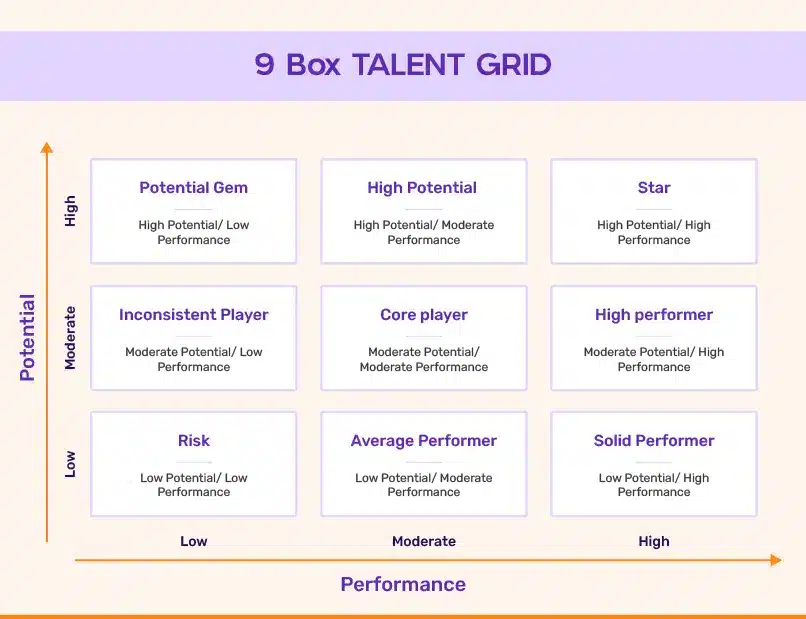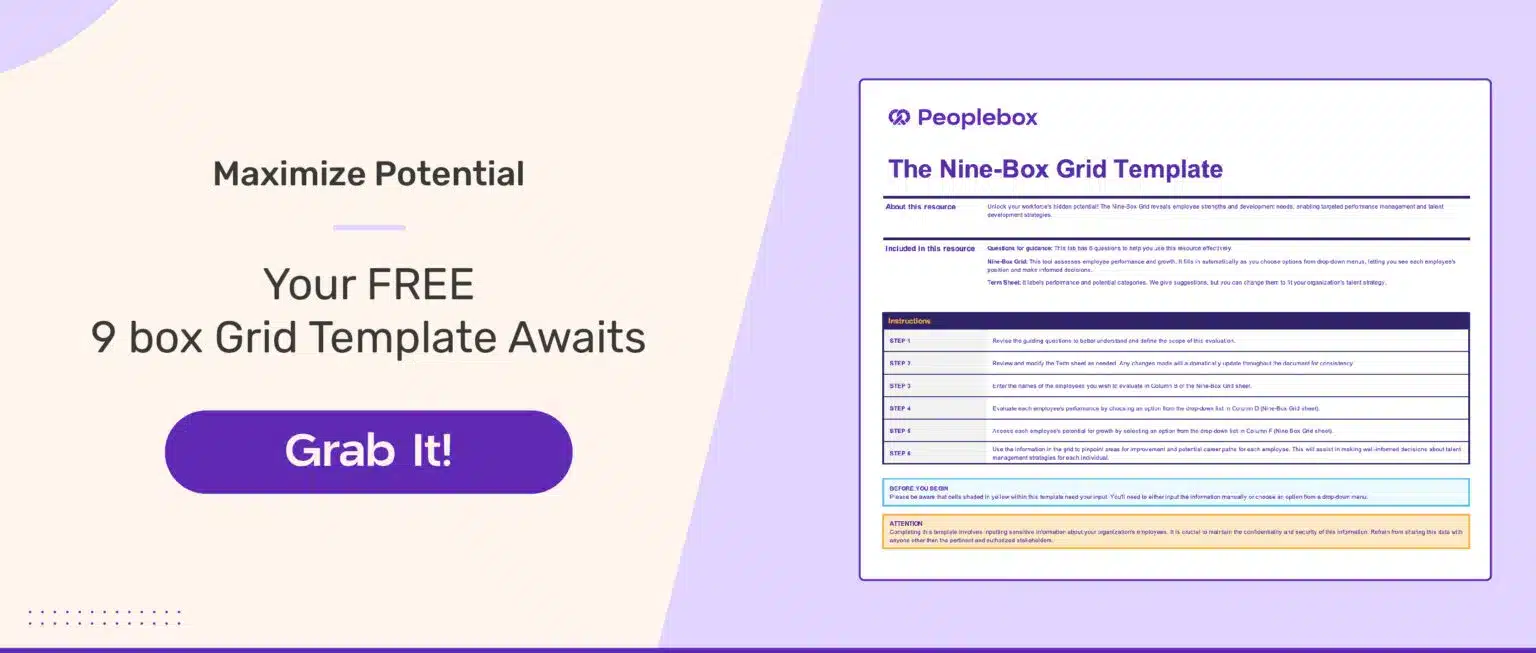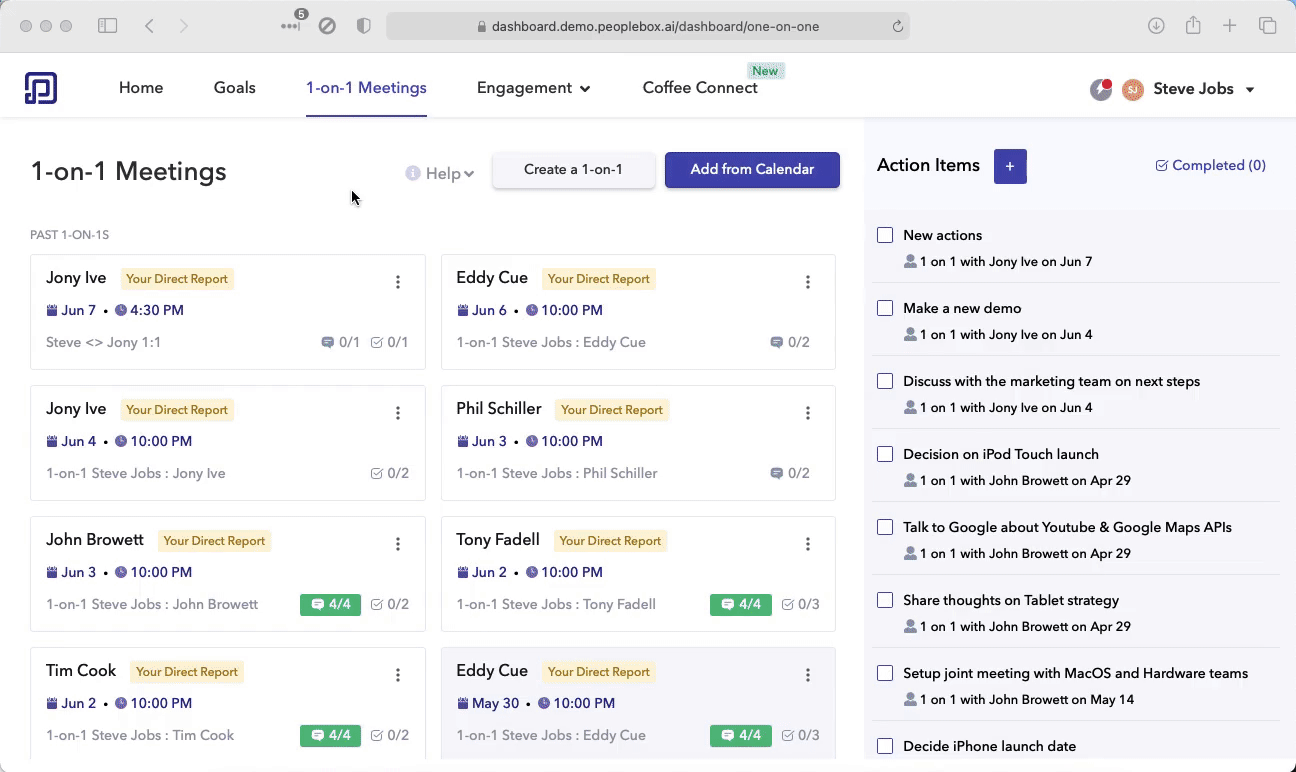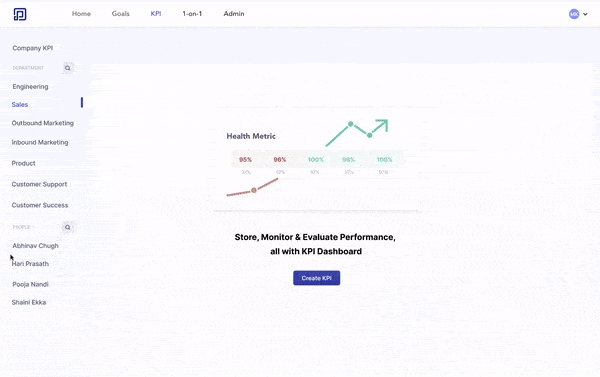When it comes to talent management, organizations are constantly seeking effective tools to assess and develop their workforce. Among these methods, the 9 box grid has emerged as an invaluable tool that has endured the passage of time.
In this blog post, we peek into the world of 9 box grid, providing you with comprehensive insights on its significance and how you can leverage it to steer your team towards success.

What is a 9 box grid?
The 9 box grid is a visual tool used in talent management to assess and categorize employees based on their performance and potential for future growth within an organization.

Components of a 9 box grid
The grid itself consists of a matrix with two axes: one measuring current performance, typically categorized as low, moderate, or high, and the other gauging an employee’s potential, also classified into low, moderate, or high.
Performance Axis
The horizontal axis of the 9 box grid serves as a compass for an employee’s current performance level. This axis categorizes individuals into three distinct tiers: low, moderate, and high performance. Accurate assessment along this axis is essential as it lays the groundwork for strategic decision-making and targeted development initiatives.
Understanding the nuances of an employee’s current performance allows organizations to identify their immediate contributions, strengths, and areas that may require improvement. This axis becomes a lens through which leaders can assess the tangible impact an individual has on the organization’s goals and objectives.
Potential Axis
The vertical axis of the 9 box grid focuses on the future, evaluating an employee’s potential for growth and advancement within the organization. Similar to the performance axis, the potential axis is segmented into low, moderate, and high categories.
Assessing potential involves looking beyond the present contributions and delving into qualities such as leadership skills, adaptability, and the ability to take on higher responsibilities. This axis guides organizations in identifying individuals who not only excel in their current roles but also show promise for greater responsibilities in the future.
Intersection and Categorization
The true power of the 9 box grid is realized at the intersection of these two axes. By plotting employees based on their performance and potential, distinct segments or boxes emerge, each representing a unique combination of these two crucial factors.
These segments, ranging from high-performing and high-potential “stars” to low-performing and low-potential “underperformers,” offer a comprehensive view of the workforce. This categorization facilitates targeted strategies for employee development, succession planning, and resource allocation, ensuring a strategic and tailored approach to people management.

The Evolution of the 9 Box Assessment Grid
The 9 Box Talent Review originated from McKinsey in 1970 and was first utilized by General Electric (GE) to identify strategic investments and assess business units. Over time, it became a widely adopted tool in the HR industry.
In 2024, the 9 box assessment grid has evolved significantly to meet the changing needs of talent management in response to dynamic market conditions, technological advancements, and evolving employee expectations.
The updated 9 box grid now offers enhanced flexibility to accommodate diverse skill sets and career paths, moving away from a one-size-fits-all approach to a more nuanced assessment that considers cross-functional expertise, leadership potential, and adaptability to change.
Additionally, the integration of the 9 box grid with Objectives and Key Results (OKRs) has created a strategic alignment, connecting individual performance and potential assessments directly to organizational objectives. This fosters a goal-oriented culture where each employee’s contribution directly impacts the company’s overall success. OKR platforms like Peoplebox are pioneers in bringing about this transformation.
Furthermore, the 9 box grid has embraced agile talent management principles, emphasizing continuous feedback, rapid skill development, and agile team structures. This shift reflects a more dynamic and responsive approach to talent management, enabling organizations to adapt swiftly to changing market dynamics and seize new opportunities.
What are the benefits of using nine box grid in talent management?
The 9 box grid is a powerful tool in talent management, offering several benefits that contribute to strategic decision-making, employee development, and overall organizational success. Here are the key advantages of using the 9 box grid:
Holistic Talent Assessment:
9 box grid provide a comprehensive view of employees by considering both their current performance and future potential. This holistic assessment helps in identifying high-potential individuals and key contributors.
Strategic Workforce Planning:
It enables organizations to strategically plan for their workforce by categorizing employees into different segments based on performance and potential. This assists in succession planning, talent development, and resource allocation.
Identification of High-Potential Talent:
Additionally, it pinpoints individuals with great potential for growth and senior roles within the organization. This identification is crucial for nurturing future leaders and ensuring a robust leadership pipeline.
Suggested Read: 15+ Types of Recruitment Methods to Hire the Top Talents
Focused Development Initiatives:
9 box grid help tailor development initiatives based on an employee’s placement on the grid. High-performing and high-potential individuals may receive targeted training and opportunities, fostering continuous growth within the organization. Conversely, for low performers, specific development goals can be established to support their improvement and align their skills with the organization’s evolving needs. If you’re not sure what goals to set, our blog post on development goals examples can come handy.
Alignment with Business Goals:
It aligns individual performance and potential with organizational objectives. This ensures that talent management strategies directly contribute to the achievement of broader business goals and objectives.
Objective Decision-Making:
They also provide a structured framework for talent discussions, reducing unconscious biases in talent assessments. The visual representation of the grid allows for more objective and data-driven decision-making.
Adaptability to Changing Dynamics:
The 9 box grid has evolved to incorporate agile talent management principles, making it adaptable to changing market conditions, technological advancements, and the dynamic expectations of the modern workforce.
Integration with OKRs Enhances Goal Alignment:
The integration of the 9 box grid with Objectives and Key Results (OKRs) ensures that individual assessments align with broader organizational objectives, fostering a culture of goal-oriented collaboration.With Peoplebox’s OKR platform, you can ensure that every individual’s objectives are aligned with the business goals, all within a single, comprehensive platform.

Continuous Improvement through Feedback:
9 box grid embrace the principles of continuous improvement by allowing for real-time feedback and continuous assessment. This ensures that talent management strategies stay responsive to evolving circumstances. Some of the best ways to ensure continuous feedback are employee surveys, one-on-ones, weekly check-ins, etc.
Here’s how simple it is to set up 1-on-1s in Peoplebox.

How to Create a Nine Box Assessment Grid Model
Crafting a 9 box Grid model for talent evaluation requires a systematic approach. Follow these step-by-step guidelines to ensure a comprehensive and effective implementation:
Step 1: Define Performance Metrics
- The first step is to define clear and measurable performance metrics relevant to organizational goals.
- Consider both quantitative and qualitative aspects to capture a comprehensive view of performance.
Step 2: Evaluate Performance Levels
- As the next step, gather performance data through regular reviews, feedback sessions, and objective assessments.
- Use performance metrics to categorize employees into distinct performance levels (e.g., low, moderate, high).
Comprehensive employee performance management solutions like Peoplebox offer detailed KPI dashboards that help you track performance metrics seamlessly.

Step 3: Identify Potential Indicators
- Determine key indicators of potential, such as leadership skills, adaptability, and growth capacity.
- Utilize developmental assessments, feedback, and discussions to gauge the potential of each employee.
Step 4: Categorize Potential Levels
- Categorize employees into potential groups (e.g., low, moderate, high) based on identified indicators.
- Recognize qualities that signify an individual’s ability to take on additional responsibilities and contribute to organizational growth.
Step 5: Plot on the Horizontal Axis
- Plot employees along the horizontal axis of the 9 box Grid based on their assessed performance levels.
- This establishes the foundation for assessing their current contributions to the organization.
Step 6: Plot on the Vertical Axis
- Plot employees along the vertical axis of the 9 box Grid based on their assessed potential levels.
- This positions employees based on their growth potential and capacity for future contributions.
Step 7: Analyze Intersection for Placement
- Analyze the intersection of an employee’s performance and potential to determine their placement on the 9 box Grid.
- Use defined categories to create a visual representation of different talent segments.
Step 8: Define Employee Categories
- Establish clear categories for each grid segment, such as “Stars,” “High Potentials,” and “Underperformers.”
- Each category represents a specific combination of performance and potential.
Step 9: Tailor Strategies for Each Category
- Develop tailored strategies for each grid category based on performance and potential assessments.
- Align talent management initiatives with the unique needs of individuals in each segment.
Step 10: Implement Targeted Development Plans
- Design targeted development plans for each category to enhance skills and address development needs.
- Focus on leadership development training, cross-functional exposure, and specialized programs as needed.
Step 11: Monitor Progress and Adjust
- Regularly monitor employee progress within each category.
- Adjust strategies and development plans based on evolving performance and potential dynamics.
Wondering what you should do for employees falling under each grid? Keep reading.
Recommendations for Employee Categories within the 9 box grid Model
Top Right Quadrant: “Stars” (High Performance, High Potential)
Individualized Development Plans
- Develop personalized growth plans focusing on expanding existing strengths and cultivating new skills.
- Include targeted learning opportunities and stretch assignments.
Leadership Training and Mentorship
- Enroll “Stars” in advanced leadership training programs to prepare them for future leadership roles.
- Facilitate mentorship with seasoned leaders to accelerate their professional development.
Succession Planning
- Acknowledge and prioritize “Stars” in succession planning for potential leaders.
- Establish a clear career path, ensuring seamless transitions into critical roles.
Recognition and Rewards
- Implement a robust recognition program to celebrate top performers.
- Offer competitive compensation, promotions, and special projects as tangible rewards for their exceptional contributions.
Top Middle Quadrant: “High Performers, Low Potential”
Skill Enhancement Programs
- Identify areas for skill improvement and design targeted training programs.
- Encourage participation in specialized workshops or courses to elevate their expertise.
Cross-Functional Training
- Provide opportunities for cross-functional training to diversify their skill set.
- Explore rotations within the organization to broaden their understanding of different functions.
Top Left Quadrant: “High Potential, Low Performance”
Performance Improvement Plans
- Establish performance improvement plans with clear objectives and timelines.
- Define specific actions and milestones, and ensure regular follow-ups.
Additional Support and Training
- Offer additional support through coaching or mentoring to address performance challenges.
- Identify specific training programs to enhance their skill set and bridge skill gaps.
Middle Right Quadrant: “Moderate Performers, High Potential”
Skill Development Initiatives
- Encourage participation in skill development initiatives aligned with their high potential.
- Provide mentorship to guide them towards roles that align with their growth trajectory.
Cross-Functional Exposure
- Facilitate cross-functional exposure to broaden their understanding of different business areas.
- Encourage participation in projects that align with their potential.
Middle Middle Quadrant: “Moderate Performers, Moderate Potential”
Continuous Feedback
- Establish a culture of continuous feedback to encourage improvement.
- Provide ongoing coaching to help them reach their full potential.
Middle Left Quadrant: “Moderate Performers, Low Potential”
Skill Enhancement and Role Exploration
- Focus on skill enhancement programs to maximize current performance.
- Encourage conversations about alternative career paths and roles that align with their capabilities.
Bottom Right Quadrant: “Low Performers, High Potential”
Performance Improvement Plans with Future Focus
- Develop performance improvement plans with a future-focused perspective.
- Combine skill development with performance milestones to unlock their potential.
Mentorship for Guidance
- Provide mentorship to guide them through performance challenges and help unlock latent potential.
Bottom Middle Quadrant: “Low Performers, Moderate Potential”
Structured Improvement Plans
- Create structured improvement plans that address both performance and potential.
- Identify specific areas for development and set achievable milestones.
Lower Left Quadrant: “Underperformers” (Poor Performance, Low Potential)
Focused Performance Improvement
- Implement intensive performance improvement plans with clear objectives.
- Offer additional support, coaching, and training to address fundamental performance challenges.
Career Path Exploration
- Engage in discussions about alternative career paths within the organization.
- Explore opportunities for lateral moves or transitions to roles better suited to their strengths.
- Provide constructive feedback on both performance and employee potential.
- Establish clear performance expectations and goals for improvement.
Now that we’ve seen how you can create the 9 box grid for your organization, let’s look at how you can implement it effectively.
Implementing the 9 Box Grid Talent Management Model in Your Organization
Integrating the 9 box Grid into your organization’s talent management strategy can be transformative, but it comes with its own set of challenges. Addressing these challenges head-on is crucial for a successful implementation. Here’s how you can overcome common hurdles:
Resistance to Change: Many employees and even leaders may resist the introduction of the 9 Box Grid due to unfamiliarity or fear of the unknown. To address this, it is crucial to foster open communication about the benefits of the 9 Box Grid. Highlighting how it aligns with organizational goals and contributes to individual growth can help alleviate concerns and build support for its implementation.
Data Accuracy Concerns: Another significant challenge is ensuring the accuracy and reliability of the data used in the 9 Box Grid. Investing in robust performance management systems is essential to ensure accurate and up-to-date data points. Additionally, providing training to HR teams on maintaining data integrity can help mitigate this concern.

Subjectivity in Assessments: The subjective nature of assessments can undermine the credibility of the 9 Box Grid. To address this, organizations should establish clear criteria for performance and potential assessments. Furthermore, providing training to ensure consistency among evaluators is crucial in maintaining the fairness and objectivity of the process.
Lack of Stakeholder Buy-In: Without the support of key stakeholders, the successful implementation of the 9 Box Grid can be challenging. It is essential to involve key stakeholders from the beginning and communicate the strategic importance of the 9 Box Grid in shaping the organization’s talent landscape. Engaging stakeholders and demonstrating the value of the tool can help garner their buy-in.
Limited Training and Awareness: Many employees and managers may lack the necessary understanding of the 9 Box Grid and its benefits. To address this, organizations should conduct comprehensive training sessions for managers and HR teams on the use and benefits of the 9 Box Grid. Creating awareness campaigns can also ensure widespread understanding and support for its implementation.
Inadequate Follow-Up Actions: Implementing the 9 Box Grid is only the first step; ensuring follow-up actions and accountability is equally important. Organizations should define clear action plans based on grid placements and ensure that managers actively follow up on development plans and provide continuous feedback to employees.
Best Practices for Utilizing the 9 box grid
Successfully leveraging the 9 box grid requires more than its mere introduction; it demands a commitment to best practices that enhance its effectiveness. Here are key strategies to maximize the potential of the 9 box grid in your organization:
Dynamic Calibration Sessions: Conduct regular calibration sessions where managers and leaders collectively review and discuss the placement of employees within the 9 box grid. This collaborative approach ensures diverse perspectives and promotes consensus on talent assessment.
Talent Mobility Planning: Use the 9 box grid as a foundation for talent mobility planning. Identify high-potential employees and facilitate their movement across roles and departments to broaden their skill sets and experiences.
Developmental Action Planning: Implement individualized developmental action plans for employees based on their placement in the 9 box grid. Tailor training, mentoring, and stretch assignments to address specific performance and potential needs identified in the grid.
Succession Pipeline Identification: Leverage the 9 box grid to identify and nurture potential succession candidates for key leadership positions. This proactive approach ensures a robust succession pipeline and minimizes disruptions in critical roles.
Integration with Performance Management: Integrate the 9 box grid with the organization’s performance management system to align individual performance evaluations with long-term potential assessments, fostering a holistic view of employee development.
Also read: What is 9 Box Talent Review and Steps to Effectively Implement It
Download Your Free 9 Box Talent Grid Template
Unlock the power of talent management with our free downloadable 9 box Talent Grid template. This user-friendly resource empowers your organization to make strategic talent decisions effortlessly.
How to Use the Template Effectively:
Download: Click the banner below to download your free 9 box Talent Grid template.
Customize: Tailor the template to your organization’s unique performance metrics and potential indicators.
Plot Employees: Easily plot your team members on the grid based on their performance and potential levels.
Analyze and Strategize: Use the visual representation to analyze talent segments and develop targeted strategies for each category.
Continuous Refinement: Regularly revisit and refine the grid to ensure it aligns with evolving organizational needs.

If you find managing the 9 box Grid daunting, consider exploring performance management platforms like Peoplebox for a seamless and effortless approach to talent management.
Peoplebox, the 9 box Grid, and Performance Management
As organizations strive to adapt to the dynamic landscape of talent management, it is crucial to embrace innovative solutions that drive continuous improvement and agility in talent management practices.
One such solution is Peoplebox, a comprehensive platform that not only enhances the implementation of the 9 box grid but also simplifies performance management processes.
Peoplebox offers a seamless and intuitive performance management system that enables organizations to streamline feedback, goal setting, and performance reviews. By leveraging Peoplebox, businesses can foster a culture of continuous feedback, data-driven assessments, and goal-oriented performance management, aligning individual contributions with organizational objectives.
Furthermore, Peoplebox empowers managers and HR professionals to conduct regular check-ins, provide real-time feedback, and facilitate meaningful performance conversations, thereby promoting employee growth and development.
Need help streamlining your performance management process? Get in touch with us today!








